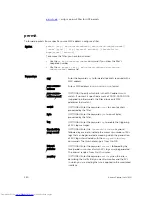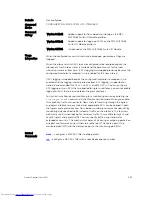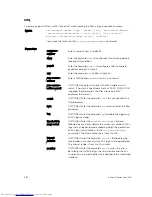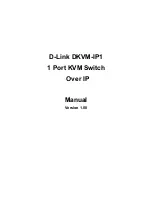
permit arp
Configure a filter that forwards ARP packets meeting this criteria. This command is supported only on 12-
port GE line cards with SFP optics; refer to your line card documentation for specifications.
Syntax
permit arp {
destination-mac-address mac-address-mask
| any}
vlan
vlan-id
{
ip-address
| any | opcode
code-number
} [count
[byte] | log] [order] [monitor] [fragments] [log [inteval
minutes] [threshold-in-msgs [count]] [monitor]
To remove this filter, you have two choices:
• Use the
no seq
sequence-number
command if you know the filter’s
sequence number.
• Use the
{
destination-mac-address mac-address-mask
| any} vlan
vlan-id
{
ip-address
| any | opcode
code-number
}
command.
Parameters
destination-
mac-address
mac-address-
mask
Enter a MAC address and mask in the nn:nn:nn:nn:nn format.
For the MAC address mask, specify which bits in the MAC
address must match.
The MAC ACL supports an inverse mask; therefore, a mask of
ff:ff:ff:ff:ff:ff allows entries that do not match and a mask of
00:00:00:00:00:00 only allows entries that match exactly.
any
Enter the keyword
any
to match and drop specific Ethernet
traffic on the interface.
vlan
vlan-id
Enter the keyword
vlan
and then enter the VLAN ID to filter
traffic associated with a specific VLAN. The range is 1 to
4094 and 1 to 2094 for ExaScale (you can use IDs 1 to 4094).
To filter all VLAN traffic, specify
VLAN 1
.
ip-address
Enter an IP address in dotted decimal format (A.B.C.D) as the
target IP address of the ARP.
opcode
code-
number
Enter the keyword
opcode
followed by the number of the
ARP opcode. The range is 1 to 16.
count
(OPTIONAL) Enter the keyword
count
to count packets
processed by the filter.
byte
(OPTIONAL) Enter the keyword
byte
to count bytes
processed by the filter.
log
(OPTIONAL, E-Series only) Enter the keyword
log
to have
the information kept in an ACL log file.
order
(OPTIONAL) Enter the keyword
order
to specify the QoS
priority for the ACL entry. The range is 0 to 254 (where 0 is
the highest priority and 254 is the lowest; lower order
numbers have a higher priority). If you do not use the
keyword
order
, the ACLs have the lowest order by default
(255).
Access Control Lists (ACL)
237
















































